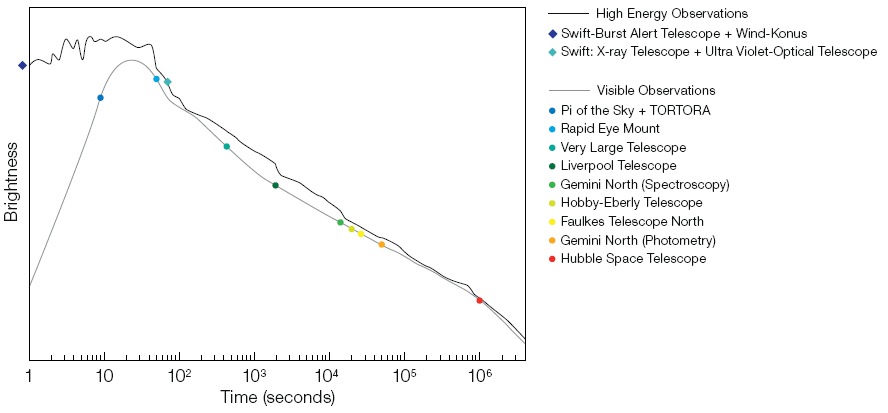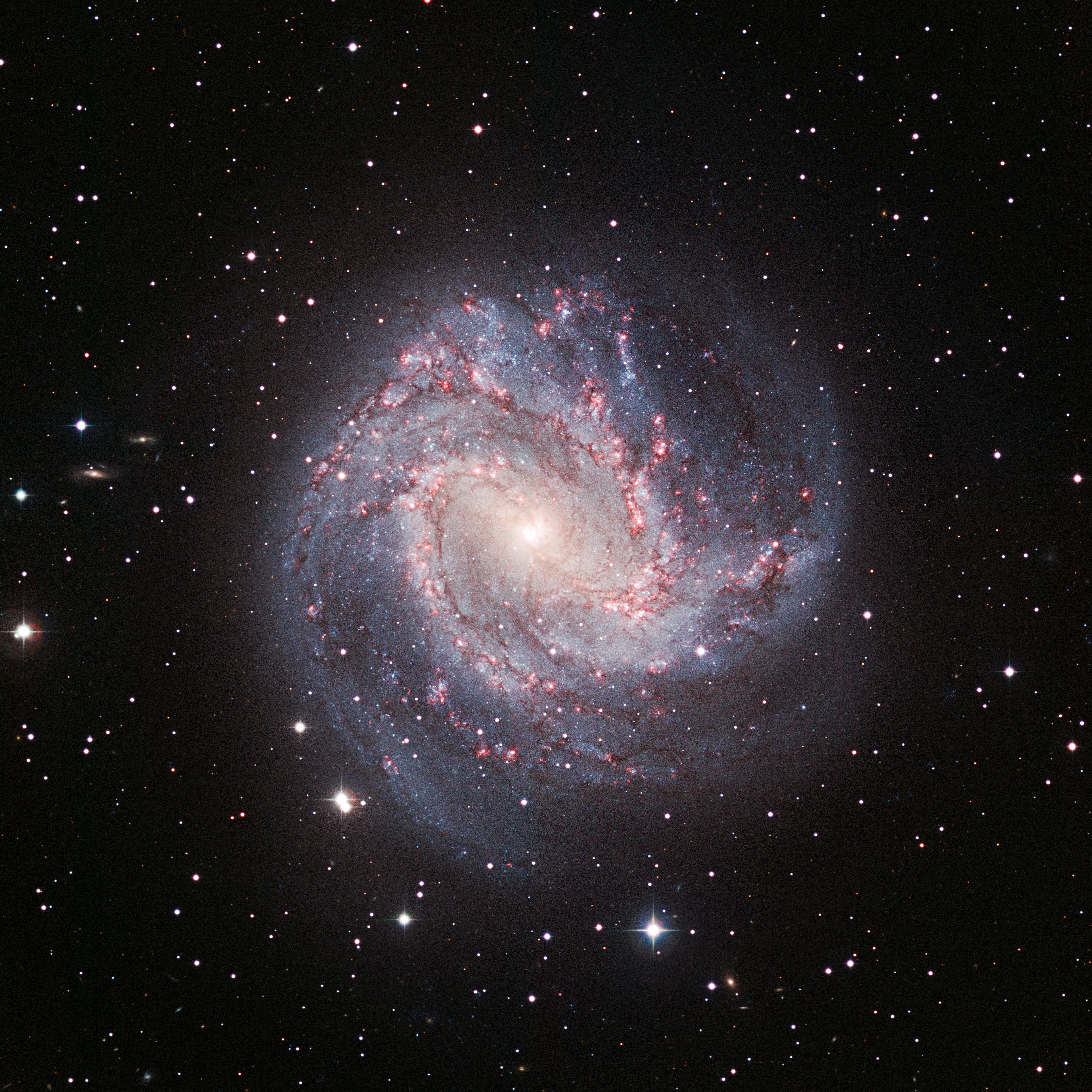|
GRB 080319B
__NOTOC__ GRB 080319B was a gamma-ray burst (GRB) detected by the Swift satellite at 06:12 UTC on March 19, 2008. The burst set a new record for the farthest object that was observable with the naked eye: it had a peak visual apparent magnitude of 5.8 and remained visible to human eyes for approximately 30 seconds. The magnitude was brighter than 9.0 for approximately 60 seconds. If viewed from 1 AU away, it would have had a peak apparent magnitude of −67.57 (21 quadrillion times brighter than the Sun seen from Earth). It had an absolute magnitude of −38.6, beaten by GRB 220101A with −39.4 in 2023. Overview The GRB's redshift was measured to be 0.937, which means that the explosion occurred about 7.5 billion () years ago (the lookback time), and it took the light that long to reach Earth. This is roughly half the time since the Big Bang. The first scientific paper submitted on the event suggested that the GRB could have easily been seen to a redshift of 16 (essentially ... [...More Info...] [...Related Items...] OR: [Wikipedia] [Google] [Baidu] |
Boötes
Boötes ( ) is a constellation in the northern sky, located between 0° and +60° declination, and 13 and 16 hours of right ascension on the celestial sphere. The name comes from , which comes from 'herder, herdsman' or 'plowman' (literally, 'ox-driver'; from ''boûs'' 'cow'). One of the 48 constellations described by the 2nd-century astronomer Ptolemy, Boötes is now one of the 88 modern constellations. It contains the List of brightest stars, fourth-brightest star in the night sky, the orange giant Arcturus. Epsilon Boötis, or Izar, is a colourful multiple star popular with amateur astronomers. Boötes is home to many other bright stars, including eight above the fourth magnitude and an additional 21 above the fifth magnitude, making a total of 29 stars easily visible to the naked eye. History and mythology In ancient Babylon, the stars of Boötes were known as SHU.PA. They were apparently depicted as the god Enlil, who was the leader of the Babylonian religion, Babyloni ... [...More Info...] [...Related Items...] OR: [Wikipedia] [Google] [Baidu] |
Reionization
In the fields of Big Bang theory and physical cosmology, cosmology, reionization is the process that caused electrically neutral atoms in the primordial universe to reionize after the lapse of the "Timeline of the Big Bang#Dark Ages, dark ages". Detecting and studying the reionization process is challenging but multiple avenues have been pursued. This reionization was driven by the formation of the first stars and galaxies. Concept Reionization refers to a change in the intergalactic medium from neutral hydrogen to ions. The neutral hydrogen had been ions at an earlier stage in the history of the universe, thus the conversion back into ions is termed a ''re''ionization. The reionization was driven by energetic photons emitted by the first stars and galaxies. In the timeline of the universe, neutral hydrogen gas was originally formed when primordial hydrogen nuclei (protons) combined with electrons. Light with sufficient energy will ionize neutral hydrogen gas. At early t ... [...More Info...] [...Related Items...] OR: [Wikipedia] [Google] [Baidu] |
Nature (journal)
''Nature'' is a British weekly scientific journal founded and based in London, England. As a multidisciplinary publication, ''Nature'' features Peer review, peer-reviewed research from a variety of academic disciplines, mainly in science and technology. It has core editorial offices across the United States, continental Europe, and Asia under the international scientific publishing company Springer Nature. ''Nature'' was one of the world's most cited scientific journals by the Science Edition of the 2022 ''Journal Citation Reports'' (with an ascribed impact factor of 50.5), making it one of the world's most-read and most prestigious academic journals. , it claimed an online readership of about three million unique readers per month. Founded in the autumn of 1869, ''Nature'' was first circulated by Norman Lockyer and Alexander MacMillan (publisher), Alexander MacMillan as a public forum for scientific innovations. The mid-20th century facilitated an editorial expansion for the j ... [...More Info...] [...Related Items...] OR: [Wikipedia] [Google] [Baidu] |
GRB 080916C
GRB 080916C is a gamma-ray burst (GRB) that was recorded on September 16, 2008, in the Carina constellation and detected by NASA's Fermi Gamma-ray Space Telescope. The burst lasted for 23 minutes (1400 s). It is one of the most extreme gamma-ray bursts ever recorded, and was the most energetic gamma-ray burst ever recorded, until GRB 221009A was recorded in 2022. The explosion had the energy of approximately 9000 type Ia supernovae if the emission was isotropically emitted, and the gas jets emitting the initial gamma rays moved at a minimum velocity of approximately 299,792,158 m/s (99.9999% the speed of light), making this blast one of the most extreme recorded.Most Extreme Gamma-ray Blast Ever, Seen By Fermi Gamma-ray Space Telescope |
Messier 83
Messier 83 or M83, also known as the Southern Pinwheel Galaxy and NGC 5236, is a barred spiral galaxy approximately 15 million light-years away in the constellation borders of Hydra (constellation), Hydra and Centaurus. Nicolas-Louis de Lacaille discovered M83 on 17 February 1752 at the Cape of Good Hope. Charles Messier added it to his catalogue of nebulous objects (now known as the Messier object, Messier Catalogue) in March 1781. It is one of the closest and brightest barred spiral galaxies in the sky, and is visible with binoculars. It has an Galaxy#Isophotal diameter, isophotal diameter at about . Its nickname of the Southern Pinwheel derives from its resemblance to the Pinwheel Galaxy (M101). Characteristics M83 is a massive, grand design spiral galaxy. Its Galaxy morphological classification, morphological classification in the De Vaucouleurs system is SAB(s)c, where the 'SAB' denotes a weak-barred spiral, '(s)' indicates a pure spiral structure with no ring, and 'c' ... [...More Info...] [...Related Items...] OR: [Wikipedia] [Google] [Baidu] |
New Scientist
''New Scientist'' is a popular science magazine covering all aspects of science and technology. Based in London, it publishes weekly English-language editions in the United Kingdom, the United States and Australia. An editorially separate organisation publishes a monthly Dutch-language edition. First published on 22 November 1956, ''New Scientist'' has been available in online form since 1996. Sold in retail outlets (paper edition) and on subscription (paper and/or online), the magazine covers news, features, reviews and commentary on science, technology and their implications. ''New Scientist'' also publishes speculative articles, ranging from the technical to the philosophical. ''New Scientist'' was acquired by Daily Mail and General Trust (DMGT) in March 2021. History Ownership The magazine was founded in 1956 by Tom Margerison, Max Raison and Nicholas Harrison as ''The New Scientist'', with Issue 1 on 22 November 1956, priced at one shilling (). An article in the magazi ... [...More Info...] [...Related Items...] OR: [Wikipedia] [Google] [Baidu] |
SN 2005ap
SN 2005ap was an extremely energetic type Ic supernova in the galaxy SDSS J130115.12+274327.5. With a peak absolute magnitude of around −22.7, it is the second-brightest superluminous supernova yet recorded, twice as bright as the previous record holder, SN 2006gy, though SN 2005ap was eventually surpassed by ASASSN-15lh. It was initially classified as type II-L, but later revised to type Ic. It was discovered on 3 March 2005, on unfiltered optical images taken with the 0.45 m ROTSE-IIIb (Robotic Optical Transient Search Experiment) telescope, which is located at the McDonald Observatory in West Texas, by Robert Quimby, as part of the Texas Supernova Search that also discovered SN 2006gy. Although it was discovered before SN 2006gy, it was not recognized as being brighter until October 2007. As it occurred 4.7 billion light years A light-year, alternatively spelled light year (ly or lyr), is a unit of length used to express astronomical distances and is equal to e ... [...More Info...] [...Related Items...] OR: [Wikipedia] [Google] [Baidu] |
Infrared
Infrared (IR; sometimes called infrared light) is electromagnetic radiation (EMR) with wavelengths longer than that of visible light but shorter than microwaves. The infrared spectral band begins with the waves that are just longer than those of red light (the longest waves in the visible spectrum), so IR is invisible to the human eye. IR is generally (according to ISO, CIE) understood to include wavelengths from around to . IR is commonly divided between longer-wavelength thermal IR, emitted from terrestrial sources, and shorter-wavelength IR or near-IR, part of the solar spectrum. Longer IR wavelengths (30–100 μm) are sometimes included as part of the terahertz radiation band. Almost all black-body radiation from objects near room temperature is in the IR band. As a form of EMR, IR carries energy and momentum, exerts radiation pressure, and has properties corresponding to both those of a wave and of a particle, the photon. It was long known that fires e ... [...More Info...] [...Related Items...] OR: [Wikipedia] [Google] [Baidu] |
Telescope
A telescope is a device used to observe distant objects by their emission, Absorption (electromagnetic radiation), absorption, or Reflection (physics), reflection of electromagnetic radiation. Originally, it was an optical instrument using lenses, curved mirrors, or a combination of both to observe distant objects – an optical telescope. Nowadays, the word "telescope" is defined as a wide range of instruments capable of detecting different regions of the electromagnetic spectrum, and in some cases other types of detectors. The first known practical telescopes were refracting telescopes with glass lenses and were invented in the Netherlands at the beginning of the 17th century. They were used for both terrestrial applications and astronomy. The reflecting telescope, which uses mirrors to collect and focus light, was invented within a few decades of the first refracting telescope. In the 20th century, many new types of telescopes were invented, including radio telescopes in t ... [...More Info...] [...Related Items...] OR: [Wikipedia] [Google] [Baidu] |
Big Bang
The Big Bang is a physical theory that describes how the universe expanded from an initial state of high density and temperature. Various cosmological models based on the Big Bang concept explain a broad range of phenomena, including the abundance of light elements, the cosmic microwave background (CMB) radiation, and large-scale structure. The uniformity of the universe, known as the horizon and flatness problems, is explained through cosmic inflation: a phase of accelerated expansion during the earliest stages. A wide range of empirical evidence strongly favors the Big Bang event, which is now essentially universally accepted.: "At the same time that observations tipped the balance definitely in favor of the relativistic big-bang theory, ..." Detailed measurements of the expansion rate of the universe place the Big Bang singularity at an estimated billion years ago, which is considered the age of the universe. Extrapolating this cosmic expansion backward in ... [...More Info...] [...Related Items...] OR: [Wikipedia] [Google] [Baidu] |






